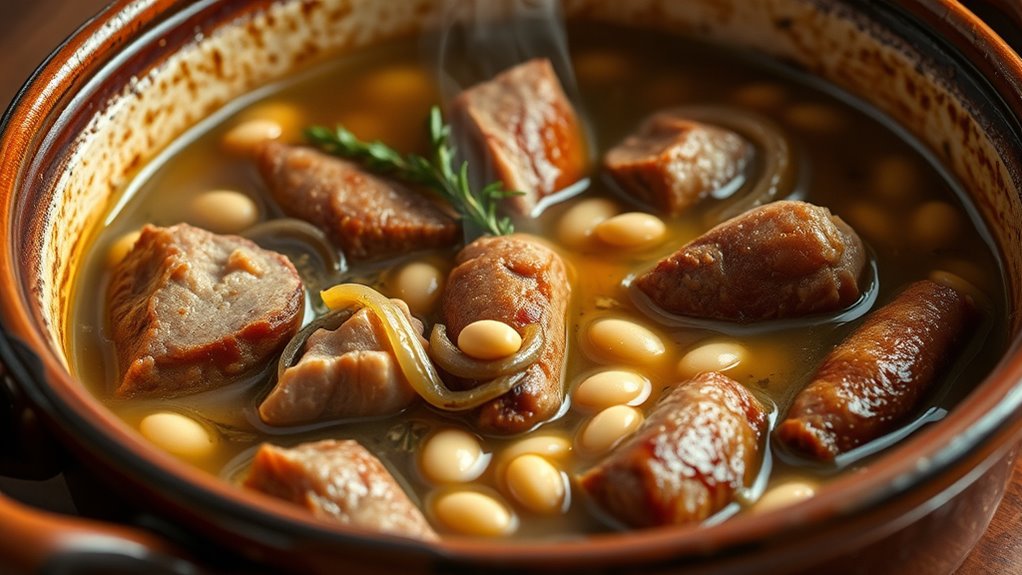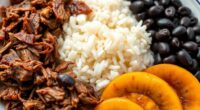Mastering slow cooking science is essential for a perfect French cassoulet. By selecting the right meats, layering ingredients thoughtfully, and cooking at low, steady temperatures, you allow collagen in the meat to turn into tender gelatin, enriching the broth and softening proteins. Beans soak up flavors, while herbs deepen aroma. Patience through cycles of cooking and resting builds complex layers. Continue exploring to reveal the full techniques behind crafting this hearty, flavorful dish.
Key Takeaways
- Slow cooking converts collagen into tender gelatin, enriching cassoulet’s texture and creating a rich, velvety broth.
- Consistent low heat prevents protein toughening and ensures even collagen breakdown for optimal tenderness.
- Proper ingredient layering, like placing sausages and duck at the bottom and beans on top, enhances flavor melding and texture.
- Extended cooking cycles allow flavors to develop fully, with resting periods helping ingredients absorb and intensify taste.
- Using quality meats and soaking beans beforehand maximizes flavor extraction and ensures a harmonious, rich final dish.
The Role of Beans in Developing Flavor and Texture

Beans are the heart of a good cassoulet, as they absorb and enhance the flavors of the broth and seasonings during cooking. When you add them, they soak up the savory juices, becoming tender yet holding their shape. Their natural starches help thicken the dish, creating a rich, cohesive texture. You’ll notice that the beans also act as a flavor sponge, drawing out the nuances of herbs, garlic, and other aromatics. As they cook slowly, they develop a depth of taste, balancing the richness of meats and the earthiness of vegetables. Properly prepared beans provide the foundation for the dish’s complexity, ensuring each bite is hearty, flavorful, and satisfying. Their role is essential in transforming simple ingredients into a classic cassoulet. Additionally, using slow cooking techniques allows the beans to fully develop their flavor and texture, making the dish even more satisfying. Incorporating proper bean preparation ensures optimal absorption and texture, which is crucial for a successful cassoulet. Employing insulation and temperature control during cooking can help maintain consistent heat, improving bean tenderness and flavor development.
The Importance of Choosing the Right Meats
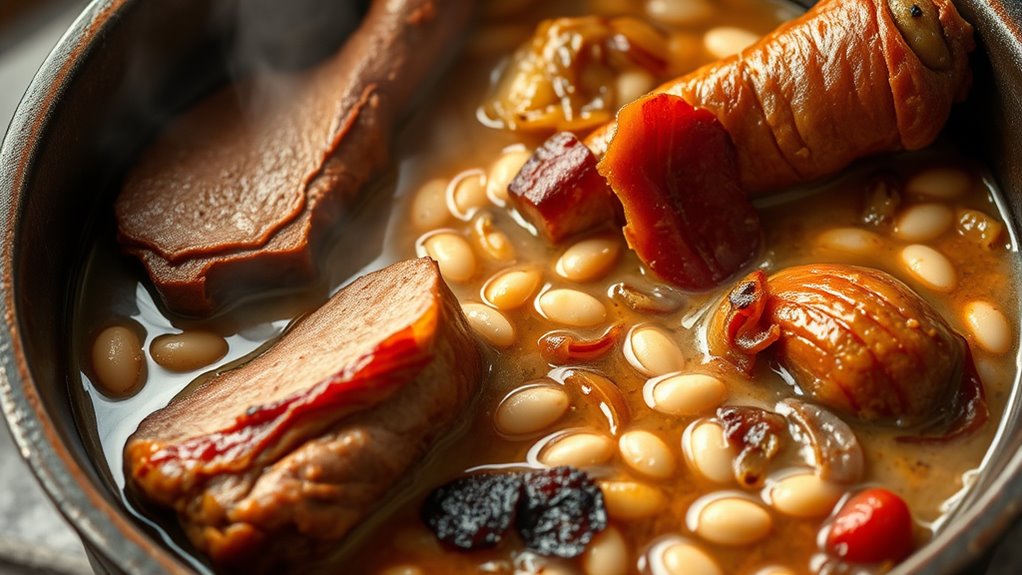
Choosing the right meats is vital to building the deep, savory flavor that defines a great cassoulet. You want cuts that become tender and release rich flavors during slow cooking. Traditionally, pork shoulder and pork belly add fattiness and depth, while sausages contribute smoky, spicy notes. Duck or goose confit introduces a luxurious, gamey richness that elevates the dish. Avoid lean meats that won’t break down or add flavor; instead, focus on cuts with enough fat and connective tissue. Properly selecting these meats guarantees they meld together over hours of cooking, creating a hearty, layered taste. Additionally, understanding the role of slow cooking in flavor development can help ensure the meats become perfectly tender and infused with savory goodness. Remember, each meat plays a crucial role in developing the complex, satisfying profile that makes cassoulet a beloved classic.
Layering Ingredients for Optimal Flavor Integration

You should carefully arrange the ingredients to guarantee every layer contributes to the overall flavor. By placing meats, beans, and vegetables strategically, you create a balanced taste in each bite. This method guarantees even flavor distribution and a richer, more cohesive cassoulet. Additionally, incorporating layering techniques or versatile ingredients can also enhance the overall experience by maximizing the use of space and flavor layers. For example, understanding the importance of proper ingredient sequencing can help ensure that each component melds harmoniously during slow cooking. Furthermore, understanding the resources and tools available can help ensure proper preparation and execution of your layering strategy. Using proper interior design principles can further elevate the presentation and ambiance of your dish.
Strategic Ingredient Arrangement
Have you ever wondered how the order of adding ingredients can elevate a dish like French cassoulet? Proper ingredient arrangement is essential for building depth of flavor. Start by placing the beans and vegetables at the bottom, creating a flavorful base. Layer the meats—duck, pork, sausages—on top, ensuring each piece touches the flavorful liquid below. This method allows flavors to meld gradually during slow cooking. Avoid mixing everything together initially, as it can hinder proper layering. Instead, think of the dish as a structure that relies on strategic placement to develop complexity. By carefully positioning each ingredient, you allow the flavors to integrate harmoniously, resulting in a rich, well-rounded cassoulet. Remember, how you layer influences both taste and texture in the final dish. Incorporating rustic decor elements can further enhance the traditional ambiance of your culinary experience.
Even Flavor Distribution
To achieve even flavor distribution in your cassoulet, focus on layering ingredients thoughtfully so each bite offers a balanced taste. Start by placing denser, flavor-rich components like sausages and duck confit at the bottom. Next, add beans and vegetables to ensure they absorb the savory juices. Top with lighter ingredients, such as herbs and breadcrumbs, for aroma and texture. Proper layering prevents ingredients from settling separately, creating a harmonious blend of flavors throughout the dish. Additionally, understanding how attention can be cultivated through consistent practice can help you maintain focus during the slow cooking process, ensuring optimal results and safety. Regularly checking your gear during the process ensures optimal results and safety. Developing indoor gardening skills can also enhance your ability to grow fresh herbs and vegetables to include in your cassoulet, elevating its flavor and freshness. Incorporating unique and wicked planters into your indoor gardening setup can provide a stylish and functional environment for your herbs and vegetables, enriching your culinary experience.
The Science of Slow Cooking and Collagen Breakdown

When you cook cassoulet slowly, heat transforms collagen from tough connective tissue into tender gelatin, enriching the dish’s texture. Over time, the prolonged heat softens proteins in the meat, making them melt-in-your-mouth. Understanding how heat and time break down these proteins helps you achieve that perfect, melt-away tenderness.
Collagen to Gelatin Transformation
Slow cooking transforms tough collagen-rich connective tissues into tender, flavorful gelatin, which is vital for the rich texture of dishes like cassoulet. When you cook collagen slowly at low temperatures, its complex protein structure breaks down into simpler molecules, releasing water and forming gelatin. This process enhances the dish’s mouthfeel, making it luscious and velvety. The longer you cook, the more collagen converts into gelatin, enriching the broth and creating a cohesive, hearty dish. Temperature control is essential; too low, and the transformation is slow, too high, and you risk breaking down other proteins prematurely. This conversion is the secret behind the luxurious, melt-in-your-mouth quality of slow-cooked cassoulet, where every bite delivers depth, richness, and a comforting texture. Understanding collagen breakdown is crucial for mastering this technique and achieving the perfect gelatin transformation. Additionally, maintaining consistent heat ensures optimal project management support, leading to a more controlled cooking process and better results.
Heat and Time Effects
The interplay between heat and time governs how collagen transforms into gelatin during slow cooking. As you gently raise the temperature, collagen begins to break down gradually, releasing its rich, sticky properties. Too much heat too quickly can toughen proteins or cause them to toughen again, so maintaining a steady, low temperature is essential. The longer you cook, the more collagen converts into gelatin, enriching the dish’s texture and flavor. This process isn’t instant; it requires patience. You’ll notice the sauce thickening and becoming more luscious as time passes. Consistent heat guarantees even breakdown, preventing overcooking or undercooking. Additionally, understanding the safety standards for toys involved in digital cooking tools can help safeguard your culinary data. Ultimately, controlling heat and time allows you to access the full potential of your ingredients, giving your cassoulet its signature tender, silky consistency.
Protein Softening Process
As you cook cassoulet over low heat, your proteins undergo a transformation driven by the breakdown of collagen into gelatin. This process softens tough cuts of meat and woody connective tissues, making them tender and flavorful. Collagen, the structural protein in meat, gradually dissolves when exposed to sustained heat and moisture, releasing gelatin that thickens the stew’s liquid. This softening enhances both texture and mouthfeel, giving the dish its characteristic richness. The slow cooking environment guarantees that collagen conversion happens gradually, preventing meat from becoming dry or stringy. By controlling temperature and cooking duration, you allow collagen to break down fully, resulting in melt-in-your-mouth tenderness and a deeply flavored, luscious cassoulet. Additionally, the moist heat of slow cooking is crucial for optimal collagen breakdown and protein softening. This method ensures a more uniform texture throughout the dish, making each bite consistently tender and rich. Furthermore, maintaining a consistent low temperature helps maximize the benefits of slow cooking, promoting thorough collagen conversion without overcooking other ingredients. Proper heat management minimizes the formation of harmful pollutants, preserving both flavor and safety. Understanding the chemical processes involved can help you refine your cooking technique for even better results.
How Herbs and Seasonings Enhance Complexity
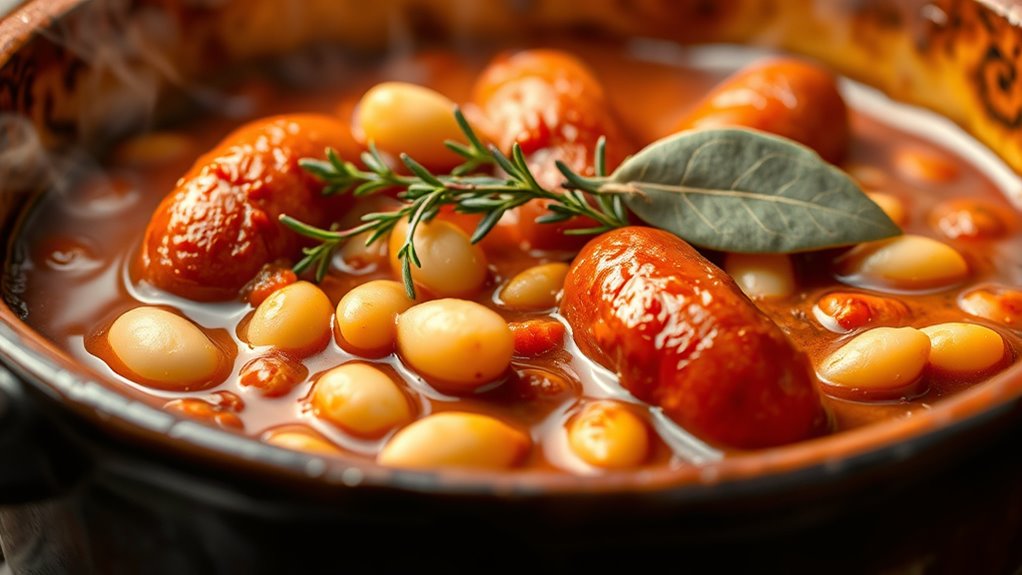
Herbs and seasonings play an essential role in elevating the complexity of a French cassoulet. They add depth by blending earthy, aromatic, and savory notes that develop as the dish slow-cooks. Fresh herbs like thyme, bay leaves, and parsley infuse the beans and meat with subtle layers of flavor, creating a harmonious balance. Dried herbs and spices—such as rosemary, marjoram, or a touch of black pepper—bring warmth and piquancy that intensify over time. You’ll find that seasoning not only enhances individual ingredients but also encourages the flavors to meld, resulting in a rich, multi-dimensional dish. Proper seasoning during slow cooking reveals a symphony of tastes, transforming a simple stew into a complex culinary experience. Additionally, understanding the influence of herbs and seasonings in traditional dishes can deepen appreciation for their cultural significance and culinary techniques. Incorporating complementary aromatic herbs can further elevate the dish’s depth and aroma, highlighting the importance of balanced seasoning in classic recipes.
The Impact of Cooking Temperature and Duration
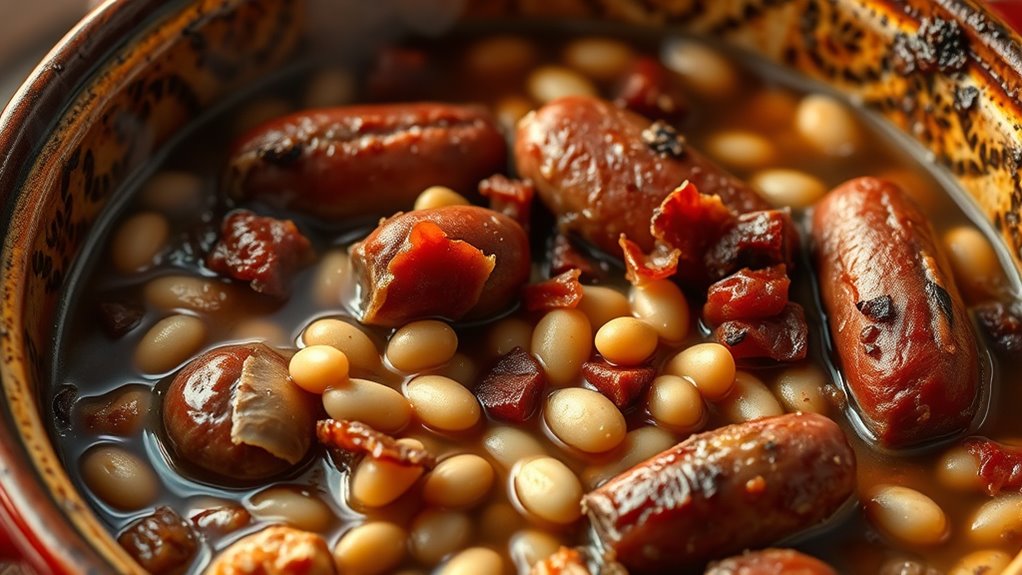
Cooking temperature and duration are crucial factors that directly influence the texture and flavor development of a French cassoulet. If you cook it too quickly or at too high a temperature, the beans may turn mushy, and the meat can become tough or dry. Slow, gentle simmering allows the flavors to meld and the ingredients to break down gradually, resulting in tender beans and succulent meat. Extended cooking time helps develop a rich, cohesive dish, as the flavors deepen and the collagen in the meats dissolves into a savory gravy. Maintaining a low, steady heat ensures even cooking and prevents scorching. You should aim for a balance—long enough to develop complexity, but not so long that the dish loses its structure or becomes overly soft.
The Formation of a Rich, Aromatic Broth
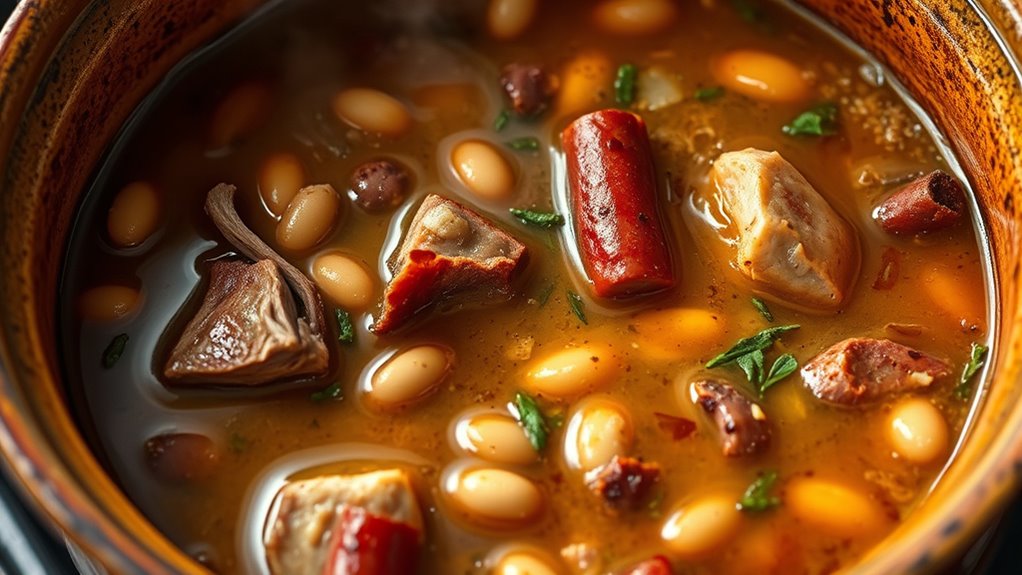
A rich, aromatic broth forms the heart of a perfect French cassoulet, and its development begins with selecting quality ingredients. You want to start with flavorful meats like pork shoulder, sausage, and duck confit, which release savory fats and juices as they cook. Adding vegetables such as onions, garlic, carrots, and celery creates a fragrant base. As you simmer, these ingredients release their flavors, blending into a unified, savory liquid. Using good-quality stock or water guarantees depth without overpowering. During slow cooking, collagen from meats dissolves, enriching the broth’s texture and giving it a velvety consistency. Stirring occasionally helps extract maximum flavor, ensuring that the broth becomes a complex, aromatic foundation that ties all the ingredients together in a delicious harmony.
The Significance of Resting and Repeated Cooking Cycles
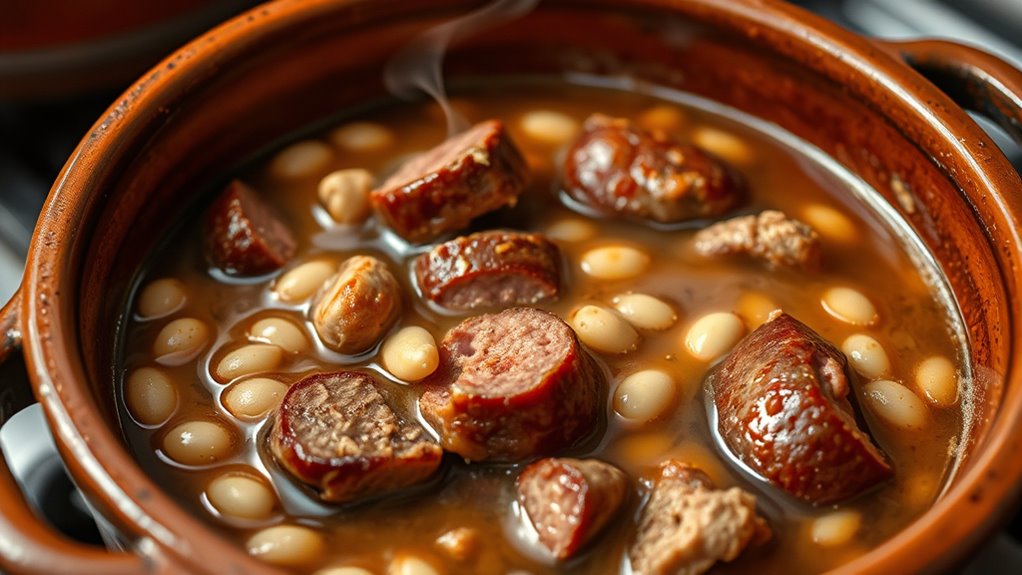
Resting and repeating cooking cycles are essential steps that deepen the flavors and improve the texture of your cassoulet. When you let the dish rest, the flavors meld, creating a richer, more cohesive profile. Resting also allows fats and juices to redistribute, giving each bite a balanced taste. Repeated cooking cycles—covering and simmering—help break down tougher ingredients and intensify the broth’s depth. During these cycles, the beans absorb more seasoning, and the meats become tender, resulting in a harmonious blend of textures. These steps aren’t just about patience; they’re about releasing the full potential of your ingredients. By giving your cassoulet time to rest and re-cook, you guarantee a deeper, more complex flavor that’s truly satisfying.
Common Techniques to Perfect Your Cassoulet

Mastering a few key techniques can elevate your cassoulet from good to exceptional. First, always start with quality ingredients—fresh herbs, good-quality meat, and properly soaked beans. Next, sear meats well to develop flavor before slow cooking. Consistent temperature control is vital; keep it gentle to avoid breaking down ingredients. Finally, regularly skim excess fat and liquid to maintain the perfect consistency. To help you remember, here’s a quick guide:
| Technique | Purpose | Tip |
|---|---|---|
| Searing Meat | Adds depth of flavor | Don’t rush; brown evenly |
| Gentle Simmering | Tenderizes ingredients | Keep at low, steady heat |
| Skimming Fat | Improves texture and flavor | Do it often during cooking |
| Resting & Repeating | Enhances flavor integration | Repeat cycles for richness |
Frequently Asked Questions
How Does Slow Cooking Influence the Nutritional Content of Cassoulet?
Slow cooking affects cassoulet’s nutritional content by preserving more vitamins and minerals compared to quicker methods. When you cook it slowly, nutrients stay intact because of lower temperatures and longer cooking times, which reduce nutrient loss. Additionally, slow cooking allows flavors to meld, making the dish tastier and more satisfying. So, by choosing slow cooking, you get a healthier, more flavorful cassoulet that retains more of its nutritional benefits.
Can Vegetarian Ingredients Be Used to Make a Flavorful Cassoulet?
You can definitely make a flavorful vegetarian cassoulet by using hearty ingredients like eggplant, mushrooms, and beans to mimic traditional flavors. Incorporate robust herbs and spices such as thyme, rosemary, and smoked paprika to enhance taste. Slow cooking helps meld these flavors beautifully, creating a rich, satisfying dish without meat. So, don’t hesitate to experiment with vegetables and plant-based proteins for a delicious, meat-free cassoulet.
What Role Does Moisture Retention Play During Long Cooking Processes?
Imagine a gentle steam rising, wrapping around your ingredients as they cook slowly. Moisture retention keeps the dish tender, juicy, and flavorful, preventing it from drying out. During long cooking, it acts like a guardian, preserving the delicate balance of flavors and textures. Without sufficient moisture, your dish risks becoming tough or bland. So, maintaining moisture is essential to achieve that rich, comforting, melt-in-your-mouth result you desire.
How Does the Choice of Cookware Affect the Final Flavor of Cassoulet?
When choosing cookware, you directly influence your cassoulet’s flavor. A heavy, enameled cast iron pot retains heat evenly, allowing slow simmering that enhances flavors and tenderizes ingredients. It also prevents scorching, preserving delicate tastes. Avoid thin or reactive pans, which can cause uneven cooking or off-flavors. Your choice of cookware guarantees the ingredients meld perfectly, resulting in a rich, authentic taste in your cassoulet.
Are There Regional Variations in Traditional Cassoulet Recipes?
You might think all cassoulet recipes are the same, but the truth is, regional variations are like different musical genres—each with its own unique flavor. In Toulouse, they favor duck confit, while Carcassonne adds more herbs and spices. These differences aren’t minor; they define the soul of each dish. So, when you cook cassoulet, you’re not just making a meal—you’re creating a regional masterpiece with every spoonful.
Conclusion
Mastering cassoulet takes patience and attention to detail, but the results are truly rewarding. Did you know that slow cooking can break down collagen in meats into gelatin, creating that rich, velvety sauce we love? By layering ingredients and allowing flavors to develop over time, you’ll craft a dish that’s both hearty and complex. Keep experimenting with your techniques, and soon you’ll be serving a perfect, soul-warming cassoulet every time.
